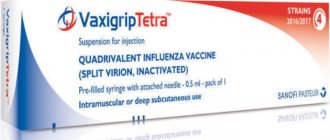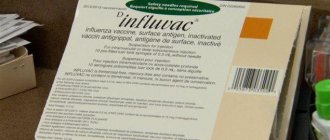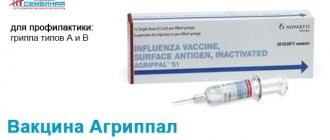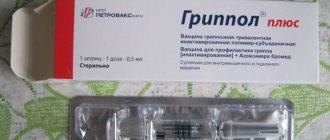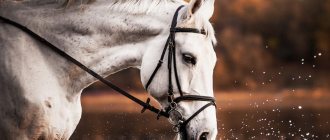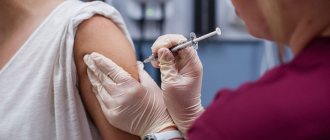Equine influenza vaccine
INSTRUCTIONS FOR THE APPLICATION OF AN INACTIVATED POLYVALENT Equine FLU VACCINE (Approved by the Veterinary Department of the Ministry of Agriculture of the Russian Federation on April 12, 2004) 1. General provisions 1.1.
Inactivated polyvalent equine influenza vaccine is a pink liquid with a white precipitate of aluminum oxide hydrate, which, when shaken, easily breaks into a uniform suspension. 1.2. The vaccine is packaged in 5, 10, 20 cm3 in sterile glass vials or ampoules. The bottles are sealed with rubber stoppers and rolled with aluminum caps. The ampoules are sealed. A label or indelible paint is placed on bottles (ampoules) with the drug: the name of the manufacturer and trademark, the name of the drug, the batch number, the control number, the amount of the drug in cm3 and the expiration date. 1.3. Labeled bottles (ampoules) are packed in 10 pieces in boxes with dividing partitions or any other ensuring the immobility and integrity of the bottles (ampoules). 1.4. A label is placed on each box indicating the name and trademark of the manufacturer, the full name of the drug, batch number, control number, date of manufacture, expiration date, number of bottles in the box, storage conditions, number of cm3 and doses in one bottle, designation of these specifications . Each box contains instructions on how to use the drug. 1.5. If the vaccine contains foreign impurities, flakes, mold, discoloration, absence of a label, as well as bottles with the vaccine that have been frozen and remnants of the drug that were not used on the day the bottle was opened, the drug is rejected and subsequently disposed of. 1.6. The shelf life of the vaccine is 12 months from the date of manufacture at a storage temperature of 2 to 8o C. 2. Biological properties. 2.1. The vaccine is used for preventive immunization of horses. Young animals are vaccinated at the age of 3 months and older. Pregnant mares are immunized no later than 3 months before their foaling. Immunity in vaccinated animals occurs 14 days after the second vaccination. 2.2. The vaccine is areactogenic and harmless. 2.3. The drug does not cause post-vaccination complications and does not have medicinal properties. 3. Procedure for using the vaccine. 3.1. The first vaccination is carried out depending on age, the second - after 2-4 weeks. Vaccinated horses are exempt from work for three days. Subsequently, they are revaccinated once every 12 months. 3.2. Vaccination of sports horses is carried out no less than 7 days before they are tested at the hippodrome. 3.3. Horses with elevated body temperature or patients with acute respiratory diseases are not subject to vaccination. They are vaccinated two weeks after recovery. 3.4. The vaccine is administered intramuscularly in a volume of 1.0 cm3 in the middle third of the neck. Before use, vaccine vials are shaken until a homogeneous suspension is formed. Syringes and needles are sterilized by boiling; a separate needle is used for each animal. 3.5. Vaccinated animals are monitored for 7 days. Their health is monitored by a veterinarian, under whose supervision the vaccinations were carried out. Some horses (with chronic bronchitis, emphysema) may have a short-term (12-24 hours) increase in body temperature. 3.6. Slaughter products are sold without restrictions. 3.7. A report on the vaccinations performed is drawn up. 4. Procedure for filing complaints. If the drug does not meet the requirements specified in this manual, and there are complications after using the vaccine, the use of this series of the drug is stopped in accordance with the instructions of the Main Directorate of the Ministry of Agriculture of Russia dated May 8, 1992 No. 22-7/28 “On the procedure for filing complaints about domestically produced veterinary drugs and purchased by import”, report this to the manufacturer and to the All-Russian State Center for Quality and Standardization of Medicines for Animals and Feed (FGU VGNKI) (123022, Moscow, Zvenigorodskoe Shosse, 5). At the same time, three bottles of this series are sent to the Center by express mail to the institute. With the approval of this manual, the “Guidelines for the use of inactivated polyvalent equine influenza vaccine”, No. 13-4-2/964, approved by the Department of Veterinary Medicine of the Ministry of Agriculture and Food of the Russian Federation on May 27, 1997, is no longer valid on the territory of the Russian Federation. Veterinary Consultation
Consult with the Veterinary Encyclopedia
Cryodestruction - vaccination against cancer
Treatment of tumors without surgery and anesthesia
Horse flu in questions and answers
Horse flu in questions and answers
What is equine flu?
Equine influenza (influenza) affects the upper and lower respiratory tract of the horse and damages the mucous membranes of the respiratory tract. The disease can lead to serious complications in young and older horses. It develops quickly: symptoms appear within 3 days after contact with the pathogen.
The virus is spread through the air and a horse can become infected either through direct contact with an infected horse or through indirect contact such as contaminated equipment or a person. It spreads rapidly among horses that have not been vaccinated. A horse suffering from influenza virus should be quarantined for up to 10 days to prevent the spread of the disease.
What are the symptoms of equine flu?
Horse flu in its course resembles the influenza virus in humans. Clinical signs caused by respiratory tract infection usually include a dry, harsh cough, nasal discharge, and fever. More serious signs include pneumonia, which can develop in some individuals, especially foals.
Flu symptoms include:
- chills, high body temperature;
- weight loss;
- loss of working qualities;
- sharp cough;
- rapid breathing;
- swollen lymph nodes;
- discharge from the nostrils;
- discharge from the eyes;
- depression;
- muscle pain (refusal to move).
How to cope with horse flu?
If you notice flu-like symptoms in your horse, act immediately, especially if you share multiple horses. Taking proactive steps can help limit the spread of the disease, saving time and money. Call your veterinarian to take samples of nasal secretions to determine what pathogen you are experiencing (a number of diseases can present with similar signs in infected horses) and treat them accordingly. It will also be useful to contact official veterinary authorities to find out where epidemics may occur.
Additionally, immediately quarantine the sick horse and thoroughly wash and disinfect all areas and equipment that the horse came into contact with. Since horses infected with influenza do not immediately show signs of illness, quarantine horses that have been in contact with the sick person; they are likely also infected. The incubation period of influenza lasts about three days, that is, from the moment the virus enters the horse’s body until its first symptoms appear, it will take about three days.
Organizational measures can help reduce the spread of disease, including assigning one person to care for and treat a sick horse, handling the horse at the end of the day or work shift when the employee will no longer be in contact with other horses, using containers of disinfectant solution to rinse shoes when entering and leaving the quarantine zone. Disinfecting equipment such as buckets, hoses, and riding equipment can also prevent the spread of disease. Regardless of the disinfection protocol, a sick horse should be given water from a separate bucket.
There is no specific treatment for equine influenza, and although antibiotics can be used to control secondary bacterial infections, they do not cure the virus itself. Your horse will need at least six weeks' rest (may be longer in severe cases).
Treatment of influenza primarily involves providing the horse with comfortable conditions (that is, providing the animal with a large amount of water, removing all stress and using non-steroidal anti-inflammatory drugs, if necessary) and keeping the animal isolated during the entire period of the disease. As a general rule, for every day of influenza fever there is a week of recovery period. A horse that has had the flu needs a three-week rest period to fully recover. Secondary infections usually pose a threat to life.
Influenza is difficult to distinguish from other respiratory diseases, which is compensated by the fact that the horse receives the same treatment in all cases.
Equine influenza is easily treatable in horses that receive plenty of rest and good care.
The influenza virus can cause secondary problems in horses, such as pneumonia, which is fatal in foals. In some severe cases, lung or liver problems can be expected to develop. The horse will feel extremely unwell, so it is recommended to refrain from any work. A horse with the flu needs a lot of rest and proper care!
Anti-inflammatory drugs can be used to reduce fever.
You should feed your horse soft food (steamed feed) and spilled hay or haylage, as a horse with a sore throat will find this food easier to swallow. Respiratory supplements will help your horse breathe easier.
It is necessary to check the horse's condition frequently to make sure that he is not cold or, on the contrary, has a fever. It is also important to provide dense, dust-free bedding on which the horse can sleep.
Recovery can be expected within a three-week period, but if the horse has not recovered by then, a veterinarian should be called.
Once fully recovered from influenza, it is important that the horse is vaccinated and given an annual booster to prevent further infection. Horses at risk of infection, such as those competing in tournaments, may need to be vaccinated against influenza more than once a year.
Flu: Frequently Asked Questions
Can a horse die from the flu?
The mortality rate for equine influenza virus is relatively low, so it is unlikely that your horse will die from this infection. However, the virus can cause pneumonia, which can be fatal in foals under 2 years of age.
Are there long-term effects of the influenza virus?
Most horses recover within three weeks, but some horses suffer from residual cough for much longer. In some individuals, complete recovery takes up to six months. The horse may develop permanent lung damage that will lead to performance problems. There is also a chance that the horse will develop muscle pain or myocarditis (inflammation of the heart muscle), which in turn can cause abnormal heart rhythms.
Is it possible to start training a horse as soon as it stops coughing?
A horse suffering from influenza needs complete rest and rest for a minimum duration of six weeks. Insufficient rest increases the risk of long-term consequences.
How far can the flu virus spread?
Influenza is a virus that quickly spreads through the air through droplets. Under favorable weather conditions, its distribution zone outdoors can reach five kilometers.
What should I do if I suspect my horse has the flu?
First, try to limit the spread of the disease by isolating your horse. The virus spreads quickly, so if other horses in contact with yours are already coughing, it is too late to isolate. Seek advice from your veterinarian immediately. He can take tests to determine what kind of infectious disease your horse is suffering from and make appropriate recommendations for treatment and return to work.
Are the signs of influenza the same in different horses?
The severity of symptoms depends on numerous factors such as age, stress, level of exercise, vaccination status, and how strong the virus is. Unvaccinated, previously untreated horses carrying the virus for the first time may show significant clinical signs, while other horses may show only mild signs that could easily be mistaken for another disease.
How can I check if new horses arriving at my stable are infected with the flu? What measures should be taken to protect other horses from possible infection?
It is recommended that all new horses be isolated for a period of three weeks. A remote paddock is suitable for this, where infected horses can develop symptoms without the risk of infecting other horses. There are tests that can be used to diagnose horses exhibiting painful symptoms. Please consult your veterinarian. Your stable should have facilities for isolating horses and a protocol in place in case of an airborne infectious disease. By taking these measures early - before an epidemic occurs - you can limit the spread of the disease throughout the stable.
How to protect a horse from the flu?
The best way to protect a horse from diseases caused by the influenza virus is regular vaccination. Vaccination does not provide complete protection and horses will show signs of having the virus if they are exposed to the virus, but the vaccine will make the disease less severe and less severe than in unvaccinated horses.
When should a horse be vaccinated?
The vaccination regimen consists of a primary course at around six months of age, two injections four weeks apart and a secondary injection after five months. After this, re-vaccination is carried out annually. (Vaccination intervals and times may vary depending on vaccine manufacturer; consult your veterinarian). In any case, the vaccine will be effective when you strictly follow all the conditions for its use recommended by the manufacturer. This also applies to the vaccination schedule.
Do I need to vaccinate my horse against the flu virus if I am not competing?
Yes, if the horse has contact with other horses. The severity of equine influenza is easy to underestimate because outbreaks are relatively rare and usually not fatal. However, the disease is detrimental to your horse's health, it can be difficult to see your horse suffer, and treatment can be expensive. By vaccinating your horse against influenza, you will be fully committed to protecting your horse from the disease.
There are different strains of the equine influenza virus, as well as different types of vaccines. What drugs should I use?
Equine influenza virus strains mutate and change over time, similar to human influenza virus strains. This gives the virus the ability to attack the immune system and overcome the barrier created by the vaccine. If the vaccine does not match the active strain, it will not protect the immune system and fight the virus that has infected the horse's body. Equine influenza strains do not change as frequently as human influenza virus strains. For humans, new vaccines are developed every year, based on which strain was most common in the previous year. Vaccines for horses are also being updated.
There are three types of vaccines . One is an inactivated, killed virus administered as an intramuscular vaccine, the second is a modified live virus administered intranasally, and the third is a canary poxvirus. All companies produce one of these types of equine influenza virus vaccines.
When initially vaccinating a horse that has not previously been vaccinated against influenza virus with type 1 vaccines, it is necessary to administer a series of three injections with monthly intervals between injections.
Only two weeks after the last injection can the horse be considered protected from the virus. After this, it is recommended to re-vaccinate horses twice a year.
The second type of vaccine is a modified live virus. The virus is modified in such a way that it loses its effectiveness and does not lead to disease, but stimulates the immune system to produce antibodies. In general, modified live vaccines stimulate the immune system better than killed virus vaccines because they are more similar to the real influenza virus. Modified live virus vaccines are intranasal vaccines injected into the nasal cavity and from there into the pharynx.
Intranasal vaccines stimulate the immune system locally - in the throat and nasal passages, but do not stimulate the immune system to produce antibodies throughout the body (in the bloodstream and lymphatic system).
Local immunity produced by a modified live virus vaccine is probably most effective because it attacks the virus at the point of entry into the body. In the case of intranasal use of a vaccine based on a modified live virus, only one dose is sufficient, even if the horse has not previously been vaccinated. This vaccine does not require revaccination, since it stimulates the formation of an extremely stable immunity of a different type. It is recommended to repeat vaccination every 6 months after the first application.
The third type is a vaccine based on a modified canary poxvirus, which serves to carry dead parts of the equine influenza virus, causing the immune system to “think” that a live influenza virus is present in the body. This type of vaccine promotes better immune development than vaccines based on a dead virus. Vaccination is carried out in the form of an intramuscular injection and requires revaccination every six months.
Most flu vaccines come in combination with herpes virus vaccines, and may also include four- or five-part vaccines for tetanus, Eastern and Western Encephalomyelitis Virus, or West Nile Virus.
How do horses react to vaccination?
In most cases, vaccines administered to horses do not have a negative effect and there are no signs that the horse has been vaccinated. But in isolated cases, some horses exhibit mild to moderate reactions to specific antigens (foreign proteins) or to adjuvants (substances added to the vaccine to enhance the immune response) found in the vaccine. The hypervirus vaccine (equine rhinopneumonia) often causes such reactions.
A horse experiencing a vaccine reaction will often be out of sorts. She may have a depressed posture, decreased mood and energy levels, as well as decreased appetite. The horse may have a fever. Muscles throughout the body and at a specific injection site may ache. The horse may move unnaturally, as if on stilts, especially if the neck muscles are affected. If muscle pain is associated with an injection in the back of the body, associated lameness may occur. There may be mild to moderate swelling around the injection site, and the horse will resist when you apply pressure to the area.
What to do if a horse shows a negative reaction to vaccination?
Often the described reactions are short-term and resolve spontaneously within 48 to 96 hours. Many horses respond well to single or double treatment with low doses of non-steroidal anti-inflammatory drugs such as phenylbutazone or fluxin. Nonsteroidal anti-inflammatory drugs usually provide immediate symptom relief within a few hours.
Even if negative reactions do not receive treatment, they exhaust themselves and disappear.
More severe are rare cases in which a horse may react with an anaphylactic reaction, similar to a human reaction to a bee sting, peanut or seafood. This condition is life-threatening and requires immediate intervention. Fortunately, most vaccines developed for horses are safe, but it is possible that the individual horse will be extremely sensitive, so it is necessary to carefully monitor the horse after vaccination to ensure that any problems are detected early.
If you know that your horse is sensitive to a particular vaccine and develops adverse reactions, pre-treatment by administering a non-steroidal anti-inflammatory drug before or at the time of vaccination is necessary. This usually completely prevents the development of adverse reactions.
The future of equine influenza
Equine influenza researchers around the world are working to critically examine influenza vaccines. One of the most important areas of research is DNA vaccine technology, which involves using viral DNA (rather than using proteins derived from disease-causing agents) to promote an immune response.
Researchers believe this vaccine offers better protection against the disease, a faster response and causes fewer adverse reactions because it lacks the antigen that horses would react to. In addition, researchers are focusing on needle-free alternatives to traditional intramuscular and intranasal vaccine administration methods.
A number of scientists are actively experimenting with spring guns that push liquid into the skin of the horse, they select the depth of injection and pressure required to achieve optimal results. At this stage of the research process, only skin irritation was achieved, not puncture. This method of administration benefits from the point of view of the effectiveness of the immune response, since the skin is involved, not muscle tissue. The skin is often exposed to cuts and scrapes, so the immune system reacts immediately. This area of research could benefit a variety of species.
Research into the innate immune response to influenza continues. Scientists are studying phenomena such as the cytokine response that triggers fever and secondary bacterial infections, to which the influenza virus is predisposed.
The main area of interest is the interspecies spread of equine influenza. Similar cases of this phenomenon have occurred in cases of human infection with avian and swine flu. And in 2004, horse flu struck dogs in Florida. The strain of this virus has now been circulating for more than seven years and is no longer identical to equine influenza because it has mutated after affecting dogs.
Researchers are looking for potential barriers that a virus faces when it successfully mutates or switches to another species, with the former presenting opportunities for infection. Are there regular contacts between species? Once in the body of another host, can the virus successfully infect the tissues of the respiratory system of that host? Can the virus then be transmitted to new representatives of the species, and if so, why is it capable of this? The most important aspect is that scientists currently do not know why some viruses can infect the body and then begin to spread, while others cannot. For example, avian influenza, which infected people in Asia several years ago, made a species jump but was not transmitted from person to person.
Viral mutations occur randomly. Many mutations have a negative effect on the virus strain, while others do not affect its virulence. Occasionally, a mutation makes a virus less recognizable to the immune system, as in the case of antigenic drift, which necessitates updated vaccines.
In order to understand the mutations of the influenza virus, scientists continue serious research. In the face of epidemics of new strains of the virus, it becomes almost impossible to update, research and produce a vaccine to quickly and effectively vaccinate large numbers of individuals. Researchers hope to discover viable vaccination methods before the virus mutates to the point where the flu virus becomes a deadly threat again.
Translation by Dina Maksimova based on materials from the sites https://veterinarycalendar.dvm360.com, https://stablemanagement.com, https://www.theridersreins.co.uk, https://thehorse.com/.
Section materials
03 September, 16:45
St. Petersburg scientists spoke about the benefits of vaccination before surgery
03 September, 12:41
Over the past 24 hours, 1,437 St. Petersburg residents were diagnosed with COVID-19
02 September, 12:25
In St. Petersburg, more than 1.3 thousand residents fell ill with Covid per day
02 September, 11:25
St. Petersburg residents have not yet developed collective immunity from Covid
01 September, 16:51


